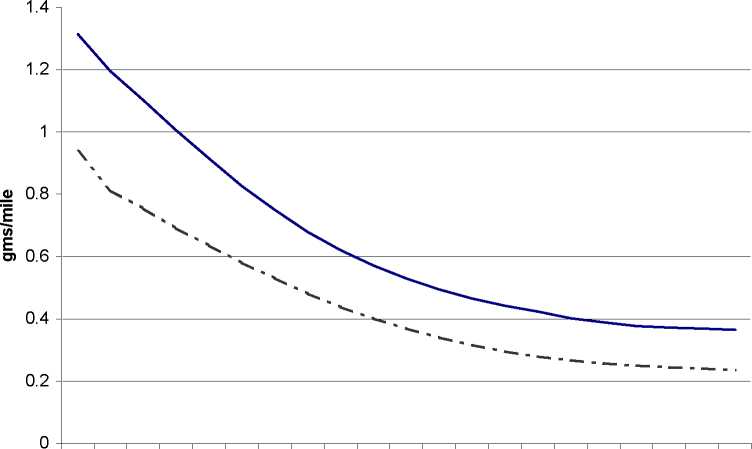Walls, Nelson, Safirova
Telecommuting and Environmental Policy
many highly polluted areas. Approaches that minimize transaction costs—wholesale approaches like
public outreach programs and eliminating regulatory obstacles to teleworking—may be warranted,
especially considering the other potential social benefits from telecommuting, most notably, congestion
benefits.
Fig. 1. Composite Emission Factors for LDGVs 2005-2025

-----NOx
----VOCs
Д? ζΩς> ς<? ζΛ4 √> ςNb ζΛlx ς<√5 ζ<J≈ √5 ζΛd ζ<3> ζd? ζΛ> √v> √i> √1> √1∕≈
φ>φ>φ>φ>φ>φ>φ>φ>φ>^λφ>φ>φ>φ>φ>φ>φ>φ>φ>φ>φ>
Year
Source: Authors’ calculations using MOBILE6
The issue of climate change offers perhaps the most hospitable context for emissions trading.
The environmental impacts of CO2 and most other greenhouse gas emissions are independent of where
they occur. A ton of CO2 emitted in Los Angeles has essentially the same environmental effect as a ton
emitted in Wyoming or India. The geographic scope of the market is much larger than for pollutants like
NOx and hydrocarbons, which affect local and regional air quality. Thus, whereas the market for NOx,
VOC, carbon monoxide, and particulate matter reductions from telecommuting will necessarily depend
on local environmental and regulatory conditions in a nonattainment area, a firm wishing to sell carbon
credits from telecommuting has a much larger potential market of buyers.
Carbon emissions are not currently regulated in the United States, but as noted above, the
European Union is preparing to implement a carbon trading regime in early 2005. The transport sector is
currently excluded from this regime but may have to be included at some point if E.U. nations have
difficulty meeting their targets under the Kyoto Protocol. Because the United States is not a signatory to
the protocol, it is not possible to trade U.S.-generated credits in the European Union or Kyoto systems.
Within the United States and Canada there are scattered voluntary trading programs, and several
northeastern U.S. states are moving to a limited cap-and-trade system for CO2 emissions; the level of the
cap is not yet known, making it impossible to forecast allowance prices.
The lack of a national and comprehensive policy on greenhouse gas emissions seriously limits
the demand for reductions. Within U.S. voluntary trading programs, prices for CO2 credits and
25
More intriguing information
1. Trade Liberalization, Firm Performance and Labour Market Outcomes in the Developing World: What Can We Learn from Micro-LevelData?2. Fiscal federalism and Fiscal Autonomy: Lessons for the UK from other Industrialised Countries
3. The name is absent
4. Regional science policy and the growth of knowledge megacentres in bioscience clusters
5. SOME ISSUES IN LAND TENURE, OWNERSHIP AND CONTROL IN DISPERSED VS. CONCENTRATED AGRICULTURE
6. An Incentive System for Salmonella Control in the Pork Supply Chain
7. The name is absent
8. Rural-Urban Economic Disparities among China’s Elderly
9. Evidence-Based Professional Development of Science Teachers in Two Countries
10. Labour Market Institutions and the Personal Distribution of Income in the OECD